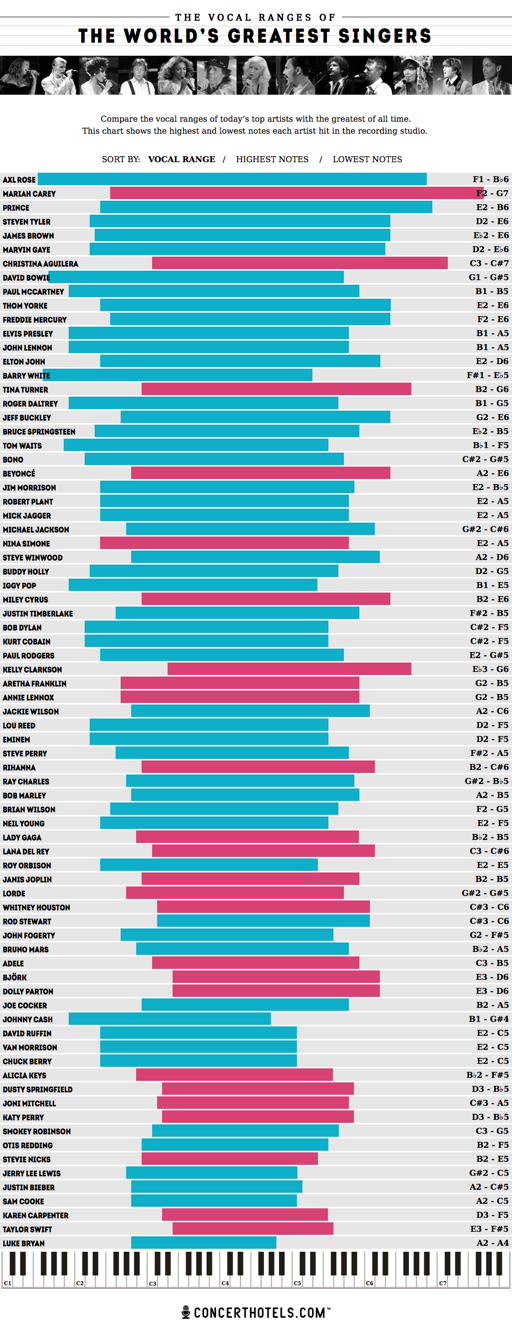Record holder Axl Rose from Guns ‘n’ Roses has a phenomenal vocal range of almost 6 octaves.
According to a research published at concerthallls.com, his lowest note is a F2 (“There was a time”), his highest a Bb6 (“Ain’t it fun”).
Without much surprise, pop diva Mariah Carey leads the female singers with her goosebumps-evoking 5 octave singing voice (F2-G7).
The Vocal Ranges of the Greatest Singers. (via ConcertHotels.com).
On average though, the human voice spans something between 2 and 3 octaves.
Now, what does it really mean and how important is it for the average singer?
Read on. Because in this article, I’ll not only address these questions…but give you some practical ideas on how to increase vocal range…and take your singing to the next level.
Vocal Range Is Probably Not What you Thought
Most singers define range as the span between your lowest and your highest note.. that you’re actually able to sing.
But what I learned is, there are some additional “hidden” notes you’d usually wouldn’t count…but still are part of your vocal range.
In other words…
ANY note that you can “produce”…even it’s barely audible…or comes with a croaky sound…is within your range.
And here’s the good news: By developing your voice, further along, you can potentially turn every falsetto tone into a full-voice note.
All you have to do is to sustain this tiny sound and blow it up to a level where the full voice kicks in.
Easier said than done. I know.
But, keeping this in mind you can understand that…
Countless hordes of singers could have a wider range.
The only difference between them and the top pros is… that singers like Axl or Mariah have learned to “sing it out loud”.
Now, let’s have some fun and find out about your own range.
Do You Know Your Range?
How deep can you sing and what’s your highest note?
If you’re interested, do this:
1. Go to this website, where you will find a great virtual piano (or if you have a real keyboard at home, you can use this).
2. Now let’s discover your lowest note. Males start at C3, females at C4. Choose a closed vowel, like an “e” to sing. In a very relaxed way, try to go down one half-step and proceed until there’s only hot air coming out of your mouth. Don’t try to push for the last note.
3. After that, start again at C3 (or C4 for females) and go up. Don’t force yourself to stay in chest voice. If you flip into head voice or falsetto, that’s okay. It will happen anyway at some point on the scale.
Now, here’s a little secret tip: When you’re approaching the higher notes, don’t think about how they may sound.
Only notice, if you still can hear a tone. As long as there’s a tone… your vocal cords close.
You’ll reach a point where despite trying to sing a note, all you will hear is air.
4. Now, count the octaves on the virtual piano from your lowest to your highest note. Here you are: That’s your current vocal range. (e.g. G2-A5 would be 3 octaves).
Best Exercises To Increase Vocal Range
The big question is this:
What’s the best way to increase your range?
First of all, we have to be aware that every voice has its natural limits due to the size and thickness of the vocal cords.
Thus, a tenor will never be able to reach bass low notes. Vice versa, a bass will never be able to sing a high C (although there might be some freak of natures out there).

Now that you know your range, you’ll have a feeling of the nature of your voice.
But anyway, the goal is to be able to sing to your full potential.
Like already outlined in 4 Ways to improve your singing voice, there are some areas you should ALWAYS work on.
Like…
1. Breathing exercises. Check out my article, which talks about the best 3 breathing exercises I know.
Once you’ve got them down, you don’t have to worry about breathing anymore.
2. Placement.
It’s basically the anchor of your whole singing. You should always produce your sound in your nose (nasal sound). That’s totally different from singing from your throat. It will give you so much more freedom and will expand your lower register to 2-3 additional notes. It’s also the place some refer to as “singing in the mask”. The easiest way to find it is to imitate a robot. Right there, where this buzzing sound appears is where you should base your singing on.
3. Stretching your palate: The antipole to your nasal anchor is your palate. The higher you go, the more space will be required. Opening up by stretching your palate will provide the additional room. A 3-note ascending scale with thirds on an open vowel like “o” will train your body and especially your palate to stretch. I call it the Krah-Krah-Krah exercise, which is extremely effective. Start your first Krah at the back of your throat and go even further back with every following note. The feeling is, that you’re actually singing outside your body. With some training, this exercise will easily add 3-4 high notes to your range.
4. Relax: The more relaxed you can keep when singing, the more easily super low and high notes will appear (note: you can’t make them!).
Don’t Impress Others – Express Yourself
Honestly, as scientifically interesting it is to know about extraordinary vocal ranges as boring it is at the same time. We’re not here to win a high note-low note-contest, neither does it tell anything about the quality of the voice or the music itself.
If you are not bound to any given standards, like in opera, anything goes. Just turn on the radio and you’ll instantly discover all kind of singers. High voices, low voices, wide range, narrow range.
Do you as a listener- really care about range or do you just like the song or not? What I try to say is, don’t focus too hard on your vocal range. It’s just one aspect of your vocal skills.
On the other hand, you can use your vocal range to express yourself and make a song more interesting. Believe me, it’s not about demonstrating 4 octaves, even if you can sing through 2,5 octaves can tremendously serve your music.
Just listen to Disturbed’s cover of “Sound of silence” (originally by Simon & Garfunkel).
Starting relatively low at F#2 and later going up to A5, singer David Draiman not only shows some good singing skills, but also building up the song’s excitement perfectly.
Wrap Up
The vocal range is one piece of a singer’s toolkit. While some supernatural singers have a range of 5-6 octaves, you can work perfectly fine with a solid 3 octaves voice.
The key to unlocking the full potential of your natural given voice is to learn proper breathing, followed by carrying the notes on a constant airflow.
The proper voice placement, which is best experienced by a buzzing sound in the area around your nose, will release tensions in your throat and give you the freedom to sing much more relaxed.
Finally, the ability to open up – achieved by stretching your palate- enables the really high notes to kick in.
Needless to say, it takes training and some amount of time to master these things. However, you can be sure, to see first results pretty quickly.
Try it out, work on it and unlock your hidden potential.
I hope you find the stuff useful. Please leave me a comment and share your experiences, progress or thoughts.
Sincerely
Felix


I am a terrible singer but my cousin is looking to get into the industry. Appreciate this great breakdown, I will definitely forward this along to her! Thanks!
I recently join the choir of my church and looking for tips to improve my voicing. Thanks for your article. I have learned the best thing to do is to use your natural voice, learn proper breathing, and keep practicing. I will definitely try it out.
Hi Felix,
I haven’t done any vocal since high school, but I remember the days of practice. Breathing exercises were the most popular ones. I could never get to the range I wanted and so I lost interest. How I wish I could hit a high note. Anyway, singing is not for everyone. I have nieces and nephews who like to sing and as I watch them, they could very well benefit from these suggestions. I will certainly share this post with them and hope they will get the right training.
Hello Felix, I have enjoyed reading this article. I am not a singer at all, but I know a few people who are. I will definitely have to point them to your website. Thanks again, and I wish you all of the success in the world!!
I’ve always battled with this idea in my head. Is your vocal range natural and you have what you have. Or can you work at it, like athletes work at sports? Glad I came across this. I’m going to give some of these exercises a try. Not expecting a miracle, but it’s nice to know there’s still hope.
Well written and thorough article. You really do not find free online information like this without either it being clickbait or behind a paywall. Thank you.
As for that list. It is missing two male singers. Halford and Dickinson.
Thanks for bringing up those two legends who also have an astounding range.
what about Nusrat Fatheh Ali khan. World’s best Qawwali singer. Listen to his voice, he has the six octaves like no other. just listen to his qawwali then you will know how much intense he sang (late). He sang with such a melody and such intensity even western people came looking for his performance from around the world, although he sang in punjabi and urdu.
Thanks for bringing him up, Djerian.
Didn’t know about this guy as I don’t personally listen to that genre.
But checking out some songs on YouTube you’re absolutely right – this man can sing astoundingly well.